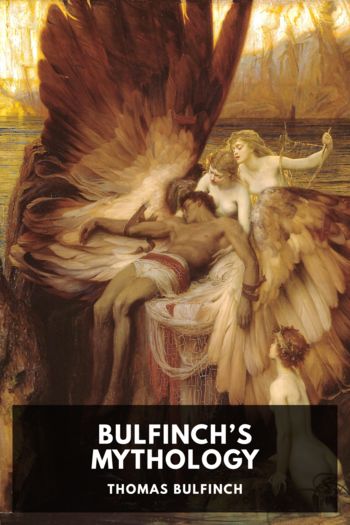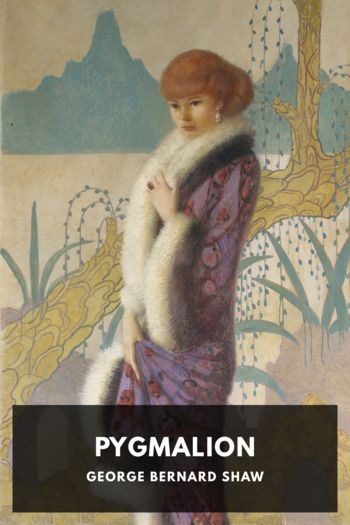Bulfinch’s Mythology, Thomas Bulfinch [love story books to read txt] 📗

- Author: Thomas Bulfinch
Book online «Bulfinch’s Mythology, Thomas Bulfinch [love story books to read txt] 📗». Author Thomas Bulfinch
The idea which the artist essayed to embody was that of the supreme deity of the Hellenic (Grecian) nation, enthroned as a conqueror, in perfect majesty and repose, and ruling with a nod the subject world. Phidias avowed that he took his idea from the representation which Homer gives in the first book of the Iliad, in the passage thus translated by Pope:
“He spoke and awful bends his sable brows,
Shakes his ambrosial curls and gives the nod,
The stamp of fate and sanction of the god.
High heaven with reverence the dread signal took,
And all Olympus to the centre shook.”37
This was also the work of Phidias. It stood in the Parthenon, or temple of Minerva at Athens. The goddess was represented standing. In one hand she held a spear, in the other a statue of Victory. Her helmet, highly decorated, was surmounted by a Sphinx. The statue was forty feet in height, and, like the Jupiter, composed of ivory and gold. The eyes were of marble, and probably painted to represent the iris and pupil. The Parthenon, in which this statue stood, was also constructed under the direction and superintendence of Phidias. Its exterior was enriched with sculptures, many of them from the hand of Phidias. The Elgin marbles, now in the British Museum, are a part of them.
Both the Jupiter and Minerva of Phidias are lost, but there is good ground to believe that we have, in several extant statues and busts, the artist’s conceptions of the countenances of both. They are characterized by grave and dignified beauty, and freedom from any transient expression, which in the language of art is called repose.
The Venus de MediciThe Venus of the Medici is so called from its having been in the possession of the princes of that name in Rome when it first attracted attention, about two hundred years ago. An inscription on the base records it to be the work of Cleomenes, an Athenian sculptor of 200 BC, but the authenticity of the inscription is doubtful. There is a story that the artist was employed by public authority to make a statue exhibiting the perfection of female beauty, and to aid him in his task the most perfect forms the city could supply were furnished him for models. It is this which Thomson alludes to in his Summer:
“So stands the statue that enchants the world;
So bending tries to veil the matchless boast,
The mingled beauties of exulting Greece.”
Byron also alludes to this statue. Speaking of the Florence Museum, he says:
“There, too, the goddess loves in stone, and fills
The air around with beauty;” etc.
And in the next stanza,
“Blood, pulse, and breast confirm the Dardan shepherd’s prize.”
See this last allusion explained in Chapter XXVII.
The Apollo BelvedereThe most highly esteemed of all the remains of ancient sculpture is the statue of Apollo, called the Belvedere, from the name of the apartment of the Pope’s palace at Rome in which it was placed. The artist is unknown. It is supposed to be a work of Roman art, of about the first century of our era. It is a standing figure, in marble, more than seven feet high, naked except for the cloak which is fastened around the neck and hangs over the extended left arm. It is supposed to represent the god in the moment when he has shot the arrow to destroy the monster Python. (See Chapter III) The victorious divinity is in the act of stepping forward. The left arm, which seems to have held the bow, is outstretched, and the head is turned in the same direction. In attitude and proportion the graceful majesty of the figure is unsurpassed. The effect is completed by the countenance, where on the perfection of youthful godlike beauty there dwells the consciousness of triumphant power.
The Diana a la BicheThe Diana of the Hind, in the palace of the Louvre, may be considered the counterpart to the Apollo Belvedere. The attitude much resembles that of the Apollo, the sizes correspond and also the style of execution. It is a work of the highest order, though by no means equal to the Apollo. The attitude is that of hurried and eager motion, the face that of a huntress in the excitement of the chase. The left hand is extended over the forehead of the Hind, which runs by her side, the right arm reaches backward over the shoulder to draw an arrow from the quiver.
The Poets of MythologyHomer, from whose poems of the Iliad and Odyssey we have taken the chief part of our chapters of the Trojan war and the return of the Grecians, is almost as mythical a personage as the heroes he celebrates. The traditionary story is that he was a wandering minstrel, blind and old, who travelled from place to place singing his lays to the music of his harp, in the courts of princes or the cottages of peasants, and dependent upon the voluntary offerings of his hearers for support. Byron calls him “The blind old man of Scio’s rocky isle,” and a well-known epigram, alluding to the uncertainty of the fact of his birthplace, says:
“Seven wealthy towns contend for Homer dead,
Through which the living Homer begged his bread.”
These seven were Smyrna, Scio, Rhodes, Colophon, Salamis, Argos, and Athens.
Modern scholars have doubted whether the Homeric poems are the work of any single mind. This arises from the difficulty of believing that poems of such length could have been committed to writing at so early an age as





Comments (0)